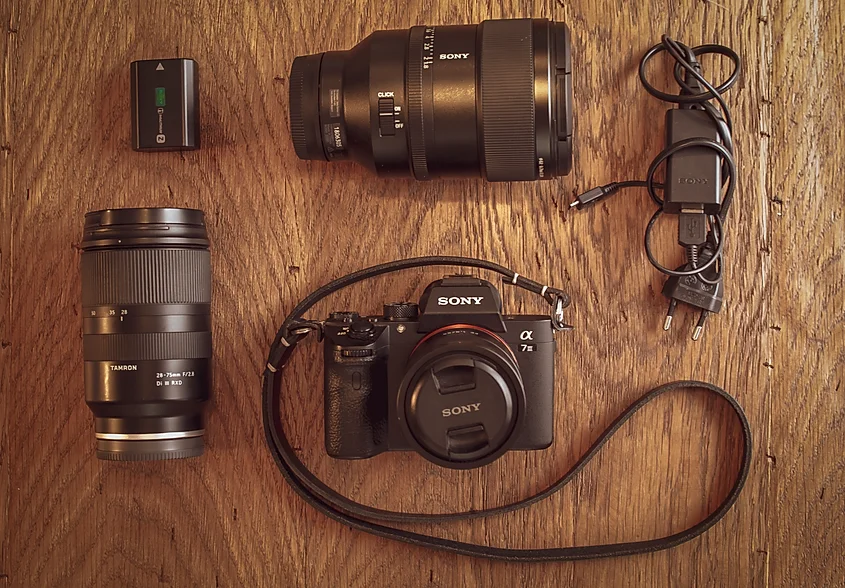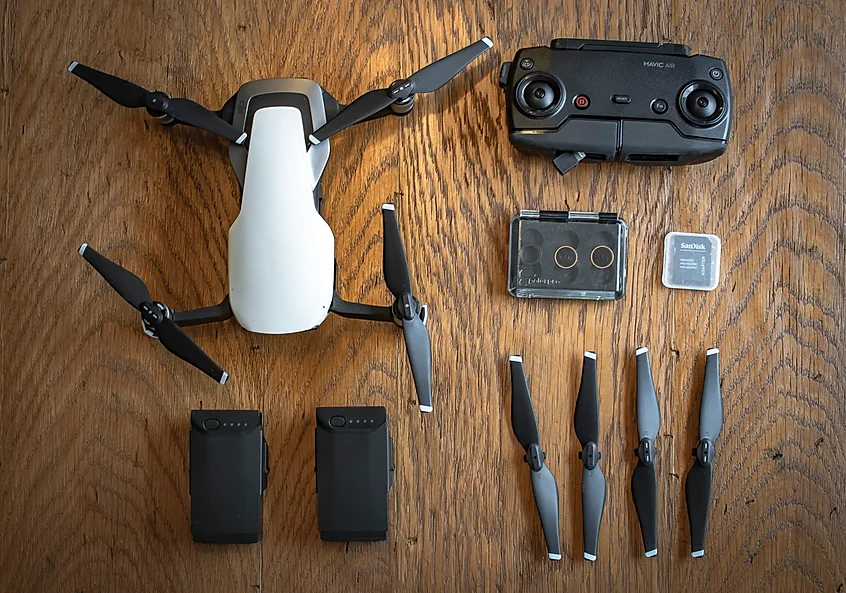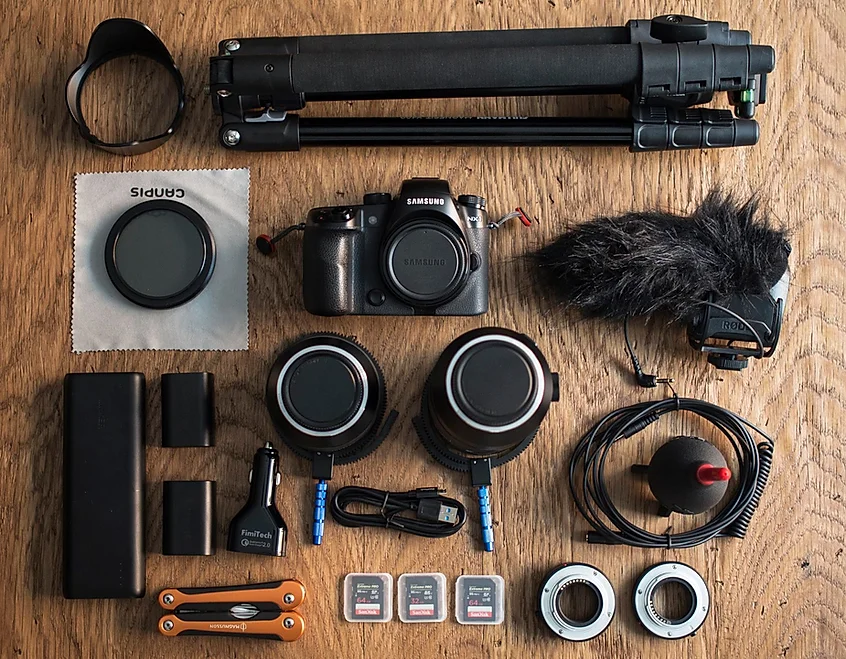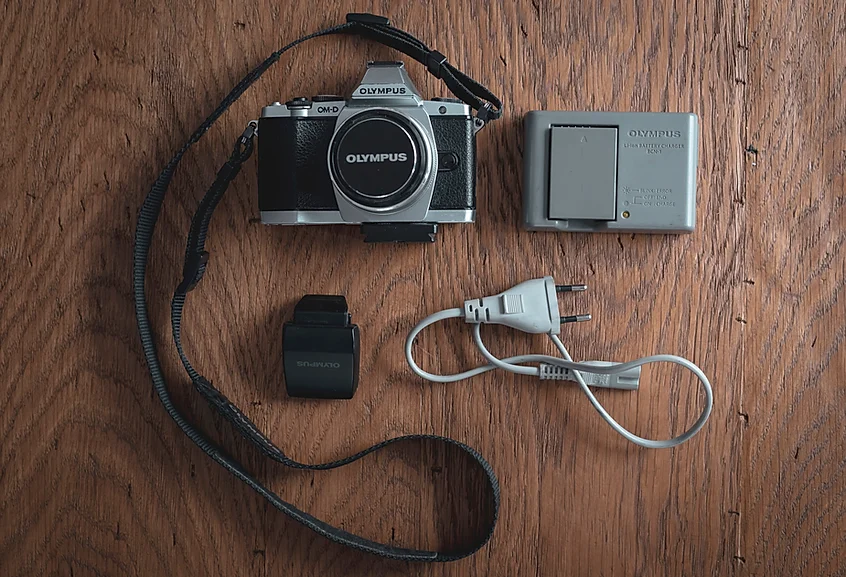
We currently have 2 Sony cameras: SONY ALPHA 7III and SONY ALPHA 7IV for which we share the lenses. We are also in process of changing our DJI MAVIC AIR drone.
SONY ALPHA 7 IV
Our most recent acquisition, we are still testing it, as it`s only been few months since we bought it.
This is mainly our video camera while we use the older Sony Alpha 7 III only for photography.
At the moment we share 4 prime lenses: Sony 35 mm ( F1.4 ), Sony 135 mm GM ( F.1.8 ), Sony 85 mm ( F.18 ) and Zeiss 55 mm.
SONY ALPHA 7 III
Until now ( and it`s been almost 4 years ), this camera hasn`t disappointed us. Although the Tamron lens is the best price-quality deal for it`s category, we must say that the Sony lens is really amazing. It`s a bit unfair to compare these 2 as they belong to completely different categories. However, the downside is that both lenses are pretty big and they significantly add a lot of weigh to the camera.
One of the things that we absolutely love and it makes this camera stand out of the crows is it`s excellent low light capability! Basically, with a high ISO ( and trust us, it can go incredibly high ) you can do street photography at night without using a tripod! Same applies when it comes to taking pictures from the flight deck at night. With the previous camera, it was absolutely impossible to shoot anything from the vibrating aircraft.
Apart from that, the level of customization this camera can achieve is top and you can actually decide if you want to use the sensor at its full frame capacity or just APSC.
The biggest downside encountered by now is its heavy weight, compared, of course, with our previous Olympus.
We have recently bought the Zeiss 55 mm ( f 1.8 ), which is more amazing than expected. It is incredibly small and light making our camera much easier to carry. On top of that, that f1.8 can get us incredible portraits but, at the same time, provides a decent landscape photography as well. Therefore, this combination – Sony A7III + Zeiss 55 mm – is simply amazing when we don`t have too much space or we`re not in the mood for carrying, but we still want stunning images.
Specifications:
- Sensor: 24.2 MP CMOS Sensor, 5.93µ pixel size
- Sensor Size: 36 x 24mm
- Resolution: 6000 x 4000
- Native ISO Sensitivity: 100-51,200
- Boost ISO Sensitivity: 50 – 204,800
- In-Body Image Stabilization: Yes
- RAW Formats: RAW (14-bit ARW), C-RAW
- Dust Reduction: Yes
- Weather Sealing/Protection: Yes
- Body Build: Full Magnesium Alloy
- Shutter: 1/8000 to 30 seconds
- Shutter Durability: Unknown
- Storage: 2x SD / SDHC / SDXC slot
- Viewfinder: XGA OLED electronic viewfinder
- Viewfinder Coverage: 100%
- Viewfinder Magnification: 0.78x
- Built-in Flash: No
- Autofocus System: 693 points (phase-detection AF), 425 points (contrast-detection AF)
- LCD Screen: 921,600 dots
- Slow Motion HD Video: 120 FPS
- Video Compression: AVCHD / MP4 Compression with 4:2:0 sampling
- HDMI Output: 8-bit with 4:2:2 sampling
- Silent Photography Mode: Yes
- Intervalometer: No
- Focus Stacking: No
- GPS: No
- WiFi: Built-in
- Bluetooth: Built-in
- Battery Type: NP-FZ100
- Battery Life: 610 shots (viewfinder), 710 shots (rear LCD)
- USB Standard: 3.0
- Weather Sealing: Yes
- Weight: 650 g (23.0 ounces) with battery and memory cards
- Size: 127 x 96 x 74 mm (5 x 3.8 x 2.9″)
- Price: $1999.99
Full list of specs can be found here.
Advantages:
Full frame, low light capability, high customization level, user friendly once you customize it ( it actually has a lot of shortcut buttons ), high, weather sealed, built in wifi and blue-tooth, silent shutter feature, dual card feature, ergonomic, really good battery life ( at least until now )
Disadvantages:
a bit heavy weight and the image size is very big so it takes a lot of space on the computer/ hard disk

DJI MAVIC AIR DRONE
The second most recent member of our photo gear family. DJI Mavic Air is a small and easy to carry drone and is the perfect tool for capturing amazing views. As well as the Olympus, it`s main advantage is that is very easy to carry wherever we go. On top of that it has 4 K video recording feature and 12 MP which give it quite a good price-quality ratio.
Specifications:
- Takeoff Weight 430 g
- Dimensions Folded: 168×83×49 mm (L×W×H) / Unfolded: 168×184×64 mm (L×W×H)
- Max Speed (near sea level, no wind)68.4 kph (S – mode[1]) 28.8 kph (P – mode) 28.8 kph (Wi-Fi mode)
- Max Service Ceiling Above Sea Level 5000 m
- Max Flight Time (no wind) = 21 minutes (at a consistent 25 kph)
- Max Hovering Time (no wind) = 20 minutes
- Max Flight Distance (no wind) = 10 km
- Max Wind Speed Resistance 29 – 38 kph
- Internal Storage 8 GB
- Stabilization 3-axis (tilt, roll, pan)
- Camera Sensor 1/2.3” CMOS
- Effective Pixels: 12 MP
- Lens FOV: 85°
- 35 mm Format Equivalent: 24 mm
- Aperture: f/2.8
- Shooting Range: 0.5 m to ∞
- ISO Range Video: 100 – 3200 (auto) , 100 – 3200 (manual)
- Photo: 100 – 1600 (auto) , 100 – 3200 (manual)
- Shutter Speed Electronic Shutter: 8 – 1/8000s
- Still Image Size 4:3: 4056×3040 , 16:9: 4056×2280
- Video resolution 4 K ultra HD
These are just a few of the specs as the list is very long. For full list view you can check out DJI website – Mavic Air specs.
We also use ND filters. More about how they work can be found here.
Advantages:
Great portability ( small and light ) ,4K video at up to 100Mbps; 12MP HDR stills, JPEG + RAW format, almost perfect obstacle avoidance, 8GB internal storage, easy to use and no previous experience required, return to home feature, 3 axis stabilization, in case of lost signal the drone returns to take-off point
Disadvantages:
Slightly jerky gimbal controls, tends to loose signal due to wi-fi usage rather than radio ( as in Mavic Pro ) and therefore the range is not that great, need multiple batteries for a great flying experience ( minimum fly more combo required ), not weather proof, not so great quality compared to a photo camera – would say it provides a good phone quality photos

SAMSUNG NX -1 -- Update: we sold it
Despite the fact that it’s not an established brand for photography, Samsung managed to shake the entire mirror-less market when it first released NX1 in 2014.
It was meant to be a challenger for the cropped sensor cameras with its never seen before 28 megapixel BSI sensor and features that are hardly present on cameras 4 years later.
For enthusiast videographers like me, it was a dream come true.
This camera it’s capable of shooting really detailed 4k footage that comes in a robust H.265 HEVC codec that was way ahead of its time. And it comes with really good ergonomics, a flat video profile, one of the best electronic viewfinders in the market up to date, focus peaking, zebra and many other features that makes shooting a pleasant experience.
It’s a real pity that Samsung decided to discontinue its camera sector.
I, for one, am still struggling to find the right replacement for my beloved NX1.
After all the camera is just a tool and as long as it does what you need to tell the story, you should hold on it. The rest it’s just marketing.
Specifications:
- 28.2 megapixel APS-C BSI-CMOS sensor
- Hybrid AF system with 205 phase-detect points covering 90% of the frame
- 15 fps burst shooting with continuous auto-focus
- 4K (DCI 4K & UHD) video recording using H.265 codec
- Can output 4:2:2 8-bit 4K video over HDMI
- Stripe pattern AF illuminator with 15m range
- Weather-resistant magnesium alloy body Context-sensitive adaptive noise reductio
- 3″ tilting Super AMOLED touchscreen display
- 2.36M dot OLED EVF with 5ms lag
- LCD info display on top of camera
- Built-in 802.11ac Wi-Fi and Bluetooth
- USB 3.0 interface
Advantages:
really fast being able to shoot 15 fps in burst mode with continuous auto – focus; outstanding dynamic range for its APS – C class and a bright OLED viewfinder with virtually no lag in addition to a good resolution touch screen; all of the features mentioned so far come at a price that is hard to beat
Disadvantages:
being discontinued is the only throwback I can see at this point.

OLYMPUS OM -D M5
Despite the fact that it is almost 6 years old, our Olympus is still a super good and reliable camera. Being a mirror less camera, it has the main advantage that is super light and easy to carry, which makes it perfect to take wherever you go. And on top of that it has a retro look which makes it look cool! 😊
We use it with 3 prime lenses: 12 mm, 25mm and 75 mm but the last one is the best for this camera. ( Be aware, on full frame sensor these equal to 24, 50 and 150 mm )
Specifications:
- 16.1MP CMOS Micro Four Thirds sensor
- 9 frames per second continuous shooting
- 35-area contrast detect AF
- ISO 200-25,600 1
- 080 HD video
- Articulated 3.0 inch touchscreen LCD with 610,000 dots
- Electronic viewfinder with 1,440,000 dots
- Raw and Raw + JPEG shooting
- Flash hot shoe and Olympus Wireless RC Flash system compatible
- Weather-sealed body
- SD/SDHC/SDXC card slot
- 5 axis image stabilization
Advantages:
compact body, light and easy to carry, retro look, user friendly menu, easy to use and perfect as a start camera, weather proof body, good price – quality ratio, image stabilization, compatible with all micro four thirds-compliant lenses
Disadvantages:
not good in low light and using ISO above about 1600 gives a lot of noise, obviously is not a full- frame and the quality of the pictures varies accordingly, small sensor
